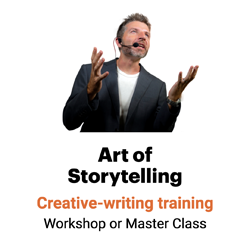Need your audience to ‘get’ your point? Use analogy
“The rewards of learning how to handle metaphor go beyond a style that is merely a bit more mannered than usual. Metaphor is a way of exploring a subject, a way of seeing a subject through a prism of new perspectives.”
— Joseph M. Williams, author, Style: Toward Clarity and Grace

That put me at the lowest point on the chart for quantity of plaque. And it put me in the 90th percentile of my peers. I left thinking I’d gotten an A. But when I went to my internist, the divine Dr. Matthew Sutton, for more details, he put it this way:
“In the race toward having a heart attack, you are beating 89 percent of other women your age.”
Oh. That’s what the 90th percentile means.
I had two takeaways from that experience.
- First, no more pate-and-brie-on-brioche sandwiches. :-(
- And second, how amazing it is that two people, armed with the same facts, told such different stories — and made such a different impact on their audience.
The first presented the information factually, with data and stats and charts and graphs. The message didn’t get through.
The second used an analogy. The metaphor made the difference.
When you have complex, technical or difficult information to convey, use metaphor. Metaphor helps your audience literally “see” your complicated point.
Metaphor makes the complex clear
A J-school friend of mine, The Wall Street Journal reporter Kevin Helliker, used that approach in his Pulitzer Prize-winning explanatory series on aneurysms. In this scene, he’s talking to his doctor about his own aneurysm:
“Some surgeons who perform these operations are quicker to dismiss the concerns other doctors have about the procedure. During a consultation with Dr. Miller, I noted that if a hose in my car were found to contain a bubble, and if a mechanic said that the bubble might last 50,000 miles or burst 10 miles down the road, I would order the hose replaced, whatever the cost. Peace of mind.”
“‘That’s a good analogy,’ Dr. Miller said, ‘except make it a King Air.'”
“‘What?'”
“‘Make it an airplane. Then the implications are similar.'”
When your doctor tells you you’re in a plane with a hose that might burst at 30,000 feet, you get it.
How can you use analogy to explain a complex idea that your readers need to understand? The metaphor makes the difference.
____
Source: Kevin Helliker and Thomas M. Burton, “The Battle of the Bulge: Aneurysm Tests Could Save A Lot of Lives, if Performed,” The Wall Street Journal, Jan. 13, 2003

Leave a Reply